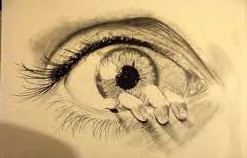Soon after I started vision improvement and began examining my feelings and habits surrounding my limited eyesight, I noticed the “reaching out” theme — I didn’t want to do it! Not with my eyes to see in the distance, nor with my personality to interact with others. On the rare occasions when I looked into someone’s eyes (I was usually looking down), it seemed the other person could see into my soul, and I felt totally invaded. Who wants that?
Reaching out to others, and welcoming them into my world, is a choice now, when I didn’t feel it was as a child. My little weak boundaries were invaded regularly and there was nothing I could do about it. No, I wasn’t beaten, but there was way too much of other people’s stuff coming at me, whether it be loud demands or “helpful” criticism or exasperated annoyance, for me to feel comfortable. I only felt safe when I was alone.

After spending many years interacting mostly with books and with computers in my small corporate cubicle, it started to dawn on me how cut off from others I was. When I began to improve my very strong nearsightedness, I quickly found this work was about a lot more than eye exercises. My intention to relax enough to welcome in the clarity was key. I had to want to see in the distance, to reach to meet that faraway image out the window, or that face across the room.
My years of energy medicine studies have taught me that most if not all physical problems have an underlying emotional component. And if we can heal the emotion, often the physical problem starts healing too. As I felt safer in small ways to reach out and interact with others, while practicing vision exercises to help my visual system improve the way I relax my eyes and focus, my eyesight gradually improved too.
In helping others improve their own eyesight, I’m repeatedly struck by the common themes, and also by how everyone is so unique. I think most vision problems arise from some flavor of not feeling it’s safe to see clearly. Yet where that belief came from is as different as our fingerprints. For one a serious childhood accident with an injury near an eye scared the visual system so much, it never felt fully safe to look again. “I never saw it coming!”. For another, sadness about the death of a friend, or overwhelm about all the school work when moving to a new grade, pushed someone into temporary myopia while trying to cope. Then being put in eyeglasses locked the condition into place.
The body and mind know how to heal, if we give them a supportive encouraging environment. This includes a positive grateful attitude. I don’t know you, but I’m willing to bet there’s a lot in your life which is going right. Most problems are not a disaster, and even little steps toward improving the situation can go a long way. I wore thick eyeglasses starting at 5 years old, then wore -10 hard contact lenses for decades, before I learned to improve my vision. My intention to heal led me forward, and my fumbling steps (and many missteps!) got me there eventually.
Yes, I am still timid sometimes, and may always like solitude more than most company. And I love my life with no barriers in front of my eyes, knowing it is safe to reach out as far as I want. There is so much to learn, and to enjoy! I can’t be part of the Dance of Life if I’m always sitting in the corner with my nose in a book. I challenge myself, gently, to keep improving, without overwhelming myself. Reaching out to make a new friend is practice for me. I notice how my vision feels safer and safer looking in the distance. I invite you to stretch yourself just a bit today, trying something new — this is how we grow.
get help on our Facebook Group!


I wore strong glasses, then contact lenses, from age 5 into my 40s. While making many mistakes, eventually l learned how to improve the way I use my eyes and to see in a more relaxed, healthy manner. It is my pleasure to coach others to do the same. Visit me at https://NancyLNeff.com.